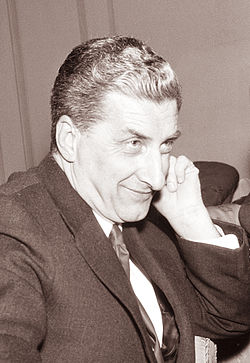This article has multiple issues. Please help improve it or discuss these issues on the talk page. (Learn how and when to remove these messages)
|
Edvard Ravnikar | |
|---|---|
 Edvard Ravnikar | |
| Born | December 4, 1907 Novo Mesto, Slovenia (Austria-Hungary) |
| Died | August 23, 1993 (aged 85) |
| Nationality | Austro-Hungarian, Yugoslav, Slovene |
| Alma mater | Faculty of Technical Sciences in Ljubljana, Technical University of Vienna |
| Occupation(s) | Architect Architectural theorist Urban designer Designer University Professor Author |
| Spouse(s) | Silva Ravnikar, born Prevec (1938–1993) |
| Children | 3 |
| Awards | Prešeren Award (1961, 1978) Plečnik Award (1974, 1987) Herder Prize (1988) |
| Practice | Yugoslav Ministry of Construction Sodobna Stanovanjska Oprema Institute for construction of Revolution Square) Faculty of Architecture Ljubljana Ambient d.o.o., Ljubljana |
| Projects | Modern gallery Ljubljana Burial ground, Rab, Croatia Burial ground, Begunje Council assembly building, Kranj National Bank building, Celje National Bank building, Kranj Faculty of Civil Engineering Hotel Creina, Kranj Hotel Maestral, St. Stefan Babylon Rotana Baghdad Hotel, Baghdad, Iraq The Republic Square, Ljubljana The residential complex Ferant Garden Department store Globus, Kranj Cultural centre Cankarjev dom National Gallery extension, Ljubljana Reconstruction of Skopje 1963 |
| Design | Modern Kitchen Concept The Articulum Furniture Covers of Arhitekt Magazine |
Edvard Ravnikar (4 December 1907 – 23 August 1993) was a Slovenian architect.
Ravnikar was born in Novo Mesto and was a student of architect Jože Plečnik. Later, he led the new generation of Slovene architects, notable for developing the Slovene architecture field's infrastructure, organizing architectural competitions etc.[1] He was a professor at the Ljubljana School of Architecture. He also promoted Scandinavian architectural style in Slovenia, particularly Finnish achievements in architecture accomplished by those such as Alvar Aalto. His most notable creations feature prominently in Ljubljana, among them Republic Square, Cankar Hall, Maximarket department store, and the Museum of Modern Art. For his work, he received the Prešeren Award in 1961 and in 1978. He died in Ljubljana, aged 85.
- ^ Modern and contemporary Slovene architecture. www.culturalprofiles.org.uk 2007 (Archived by WebCite)